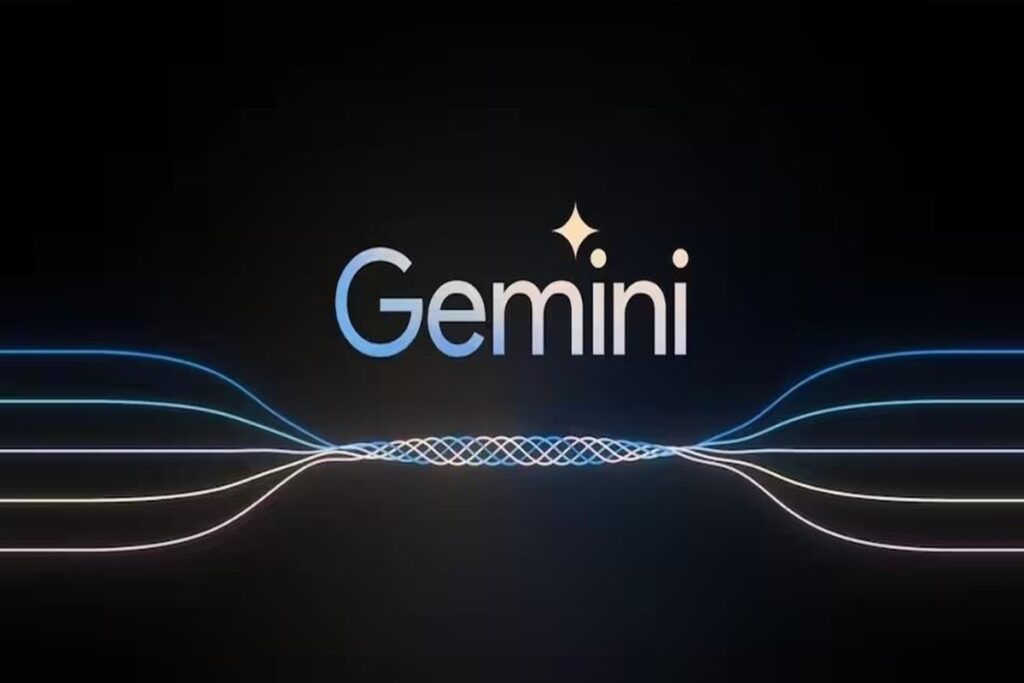Table of Contents
ToggleCompetition in this AI-ruled era is no longer astonishing. Microsoft’s Copilot AI chatbot is now integrating OpenAI’s latest model, GPT-4 Turbo, alongside image generator DALL-E 3. Anthropic’s Claude 2.1 can analyze as many as 1,50,000 words in a single prompt, which is claimed to be an industry first. But why should Microsoft have all the fun? To give tough competition to Microsoft, Google’s CEO, Sundar Pichai inaugurates Gemini, Google’s latest large language model (LLM), which is more than a single AI model. Now available on Bard and Pixel Pro, Gemini will bring some monumental revolution and claims to de-throne GPT-4 down the line.
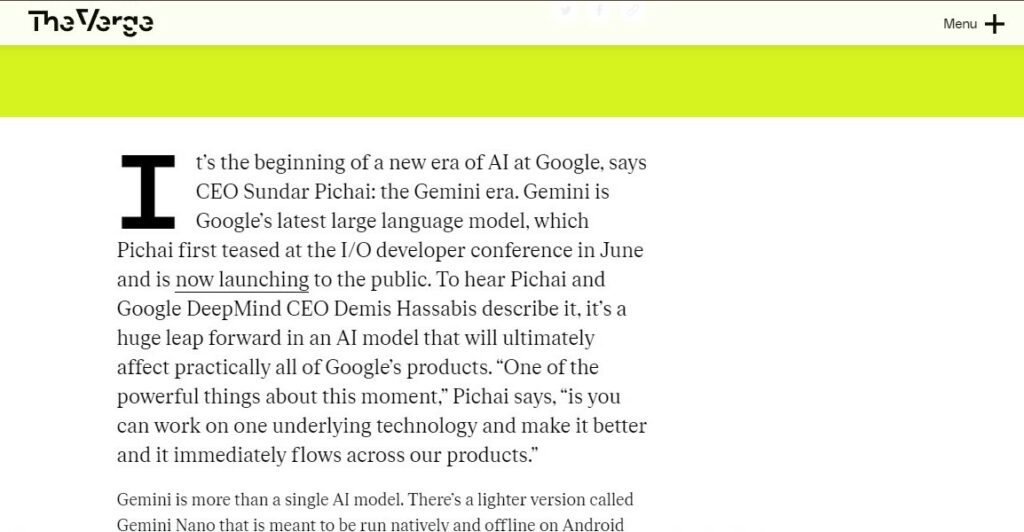
Source: Google’s CEO Sundar Pichai on Google Gemini
What is Google Gemini?
Google’s next-generation foundation model, Gemini, has already been launched, and the world of artificial intelligence is going crazy! It is expected to be more capable, flexible, and better optimized for smartphones. Gemini is the first AI model to score more than 90% on the MMLU, or Massive Multitask Language Understanding as compared to OpenAI’s GPT-4 score with an 86.5% average. This consequently gives a clear picture of how well a model understands language and can proceed with problem-solving. It’s a bang-on family legacy. AlphaGo (2016), Bert (2018), LaMDA (2020), MUM (2021), and PaLM 2 (2023), its predecessors.
Moreover, Gemini uses a robust combination of 57 subjects, such as math, physics, history, law, medicine, and ethics for testing both world knowledge and critical problem-solving abilities. Another massive advantage of Google’s Gemini is that it can understand, thoroughly explain, and efficiently generate superior-quality codes that are among the world’s most significant programming languages, like Python, Java, C++, and Go. It is now available in more than 170 countries and will empower Google’s chatbot, Bard, to the next level.

Source: Eli Collins on Google Gemini
Gemini 1.0 is optimized for three different sizes, Nano, Pro, and Ultra. Google Bard is integrated with Gemini Pro and Pixel 8 Pro (Android 14) users are enjoying the luxurious benefits of Gemini Nano, while the Ultra version will launch next year. Developers and enterprise customers will have access to Gemini Pro through Google Generative AI Studio or Vertex AI in Google Cloud starting on December 13th. The Gemini LLM-AI model is currently available in English but will gradually be able to take prompts in multiple languages.

Source: Google Images
- Gemini Ultra — largest and most capable model for highly complex tasks
- Gemini Pro– best for scaling across a wide range of tasks (Bard has this version)
Gemini Nano– most efficient model for on-device tasks
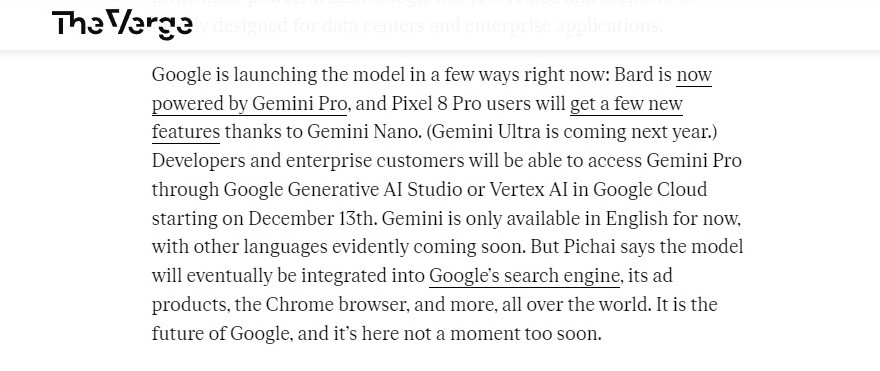
Source: Developers and enterprise customers will be able to access Gemini Pro
Google has commenced testing Gemini in the Search domain, focusing on enhancing the Search Generative Experience (SGE) to provide faster performance for users. This includes a 40% reduction in latency in English in the US, along with enhancements in quality.
How to use Google Gemini for Image Generation?
Gemini is the most flexible model of Google. The primary justification for Google labeling Gemini as its most advanced model lies in the engine’s multimodal capability. To put it simply, this new technology can adeptly manage the generation and interpretation of a more diverse range of data than ever before. DALL-E 3 has been one of the most popular AI tools for image generation but with Google Gemini, things are pretty straightforward and subtle.
If you’re one of the lucky people who can use Google’s AI image generation, getting started is super simple. First, make sure you’re part of Google’s SGE testing program. Once that’s set:
- Just open up Google Search and type in a prompt for generating an image.
- Wait a few seconds.
- Check out the four image options provided by SGE.
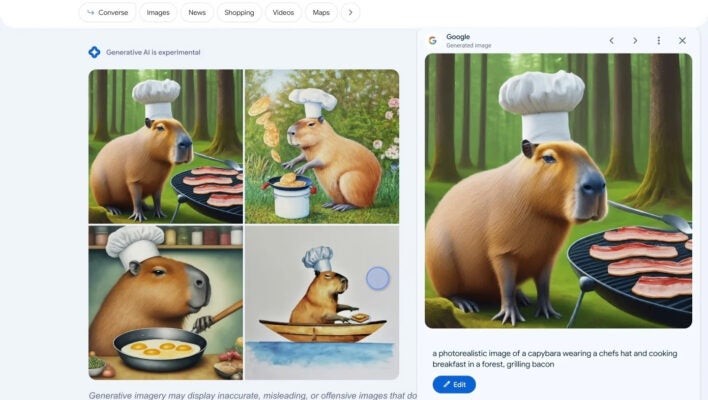
Source: Image generated by Google Gemini
That’s it! You also get an option to make subtle changes in the images Gemini has generated. To tweak the images, you have to pick one and adjust the description to add more details. Google gives a quirky example like creating a “photorealistic image of a capybara cooking breakfast in the forest” to show how it works. You can then effortlessly edit details. If you’ve ever used ChatGPT prompts, this process will feel familiar, but it’s pretty straightforward even if you haven’t.
Why Gemini is Considered to be Superior to GPT-4?
While text generation, latency, language, etc., are already on the track, AI image generation has still been somewhat controversial given the deepfake AI content available on the internet. Gemini excels in this genre as all AI-generated images will come out with a watermark and ‘metadata labeling’ tag. This will show everyone that content was made by AI and will to some extent cease the outspread of false information.
The table below shows a distinct difference between Gemini Ultra and GPT-4 in terms of text module:
| Capability | Benchmark (Higher is better) | Description | Gemini Ultra | GPT-4 (AI numbers calculated where reported numbers were missing) |
| General | MMLU | Representation of questions in 57 subjects (incl. STEM, humanities, and others) | 90.0%CoT@32* | 86.4%5-shot* (reported) |
| Reasoning | Big-Bench Hard | A diverse set of challenging tasks requiring multi-step reasoning | 83.6%3-shot | 83.1%3-shot (API) |
| DROP | Reading comprehension (F1 Score) | 82.4Variable shots | 80.93-shot (reported) | |
| HellaSwag | Commonsense reasoning for everyday tasks | 87.8%10-shot* | 95.3%10-shot* (reported) | |
| Math | GSM8K | Basic arithmetic manipulations (incl. Grade School math problems) | 94.4%maj1@32 | 92.0%5-shot CoT (reported) |
| MATH | Challenging math problems (incl. algebra, geometry, pre-calculus, and others) | 53.2%4-shot | 52.9%4-shot (API) | |
| Code | HumanEval | Python code generation | 74.4%0-shot (IT)* | 67.0%0-shot* (reported) |
| Natural2Code | Python code generation. New held out dataset HumanEval-like, not leaked on the web | 74.9%0-shot | 73.9%0-shot (API) |
Source: Distinct Difference Between Gemini Ultra and GPT-4 in Terms of Text Module
Gemini was initially designed to be natively multi-modal while pre-trained on different modalities from the very beginning. Gemini, therefore, understands and deals with all kinds of inputs substantially better than existing multi-modal models. Google also claims that due to its score of 90% on the MMLU, it has the potential to solve complex issues more efficiently than GPT-4. As a result, it may take on Open AI and make Google Bard even stronger.
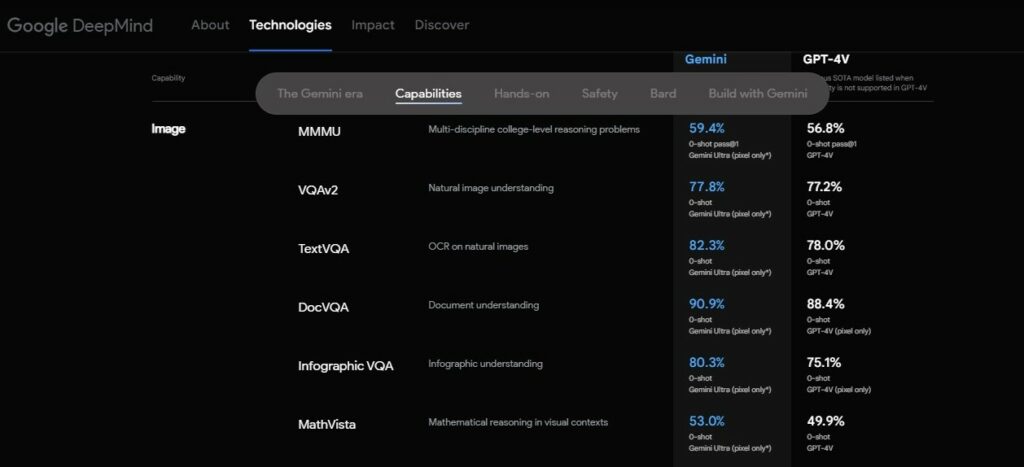
Source: Comparison between Google Gemini and GPT-4 concerning Image generation
What will Ultra bring that the current Gemini models don’t? It’ll have a more refined function, thanks to something called reinforcement learning from human feedback (RLHF). In 2024, Bard Advanced is going to make its public appearance and it is expected to be another magnificent scenario. It’s a Bard interface that includes the newest models, like Ultra once it’s ready. But before that, you can easily start using the Gemini Pro model right now. Just go to Bard and start chatting, just like you would with any other AI.
Conclusion
Gemini is trained using Google’s Tensor Processing Units which is quicker and more cost-effective to operate compared to Google’s earlier models such as PaLM. In addition to this new model, Google is introducing the TPU v5p, an updated version of its Tensor Processing Unit system. This computing system is specifically crafted for data center use, supporting the training and execution of extensive models at a large scale. Overall, Gemini seems to be quite promising and down the line, as claimed by the CEO, may overtake GPT-4 given its versatile features and faster actions. AI is going to be the ultimate future and Gemini’s contribution in that world will be undoubtedly impeccable!
